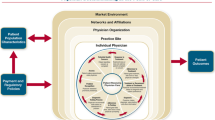Abstract
Background
Despite the proliferation of clinical practice guidelines (CPGs), physicians have been slow to adopt them.
Objective
Describe changes in the reported effect of CPGs on physicians’ clinical practice over the past decade, and identify the practice characteristics associated with those changes.
Design and Participants
Longitudinal and cross-sectional analyses of rounds 1–4 of the Community Tracking Study Physician Survey, a nationally representative survey, conducted periodically between 1996 and 2005.
Measurements
The cross-sectional outcome was the reported effect of CPGs on the physician’s practice (very large, large, moderate, small, very small, and no effect). The longitudinal outcome was the change in reported effect of CPGs between two consecutive rounds for panel respondents. Independent variables included changes in physicians’ practice characteristics (size, ownership, capitation, availability of information technology (IT) to access guidelines, whether quality measures and profiling affect compensation, and revenue sources).
Results
The proportion of primary care physicians reporting that CPGs had a very large or large effect on their practice increased significantly from 1997 to 2005, from 16.4% to 38.7% (P < .0001). The corresponding change for specialists was 18.9% to 28.2% (P < .0001). In longitudinal multivariate analyses, practice characteristics associated with an increase in effect of CPGs included acquiring IT to access guidelines, an increase in the impact that quality measures and profiling have on compensation, and an increase in the proportion of practice revenue under capitation or derived from Medicaid.
Conclusions
Promotion of wider adoption of health IT, and financial incentives linked to validated quality measures, may facilitate further growth in the impact of CPGs.


Similar content being viewed by others
References
Tunis SR, Hayward RS, Wilson MC, et al. Internists’ attitudes about clinical practice guidelines. Ann Intern Med. 1994;120(11):956–63 (Jun 1).
Flores G, Lee M, Bauchner H, Kastner B. Pediatricians’ attitudes, beliefs, and practices regarding clinical practice guidelines: a national survey. Pediatrics. 2000;105(3 Pt 1):496–501 (Mar).
Hayward RS, Guyatt GH, Moore KA, McKibbon KA, Carter AO. Canadian physicians’ attitudes about and preferences regarding clinical practice guidelines. CMAJ. 1997;156(12):1715–23 (Jun 15).
Cabana MD, Rand CS, Powe NR, et al. Why don’t physicians follow clinical practice guidelines? JAMA. 1999;282:1458–65.
Wolfe RM, Sharp LK, Wang RM. Family physicians’ opinions and attitudes to three clinical practice guidelines. J Am Board Fam Pract. 2004;17(2):150–7 (Mar–Apr).
Ornstein S, Jenkins RG, Nietert PJ, et al. A multimethod quality improvement intervention to improve preventive cardiovascular care: a cluster randomized trial. Ann Intern Med. 2004;141(7):523–32 (Oct 5).
Stone EG, Morton SC, Hulscher ME, et al. Interventions that increase use of adult immunization and cancer screening services: a meta-analysis. Ann Intern Med. 2002;136(9):641–51 (May 7).
Chaix-Couturier C, Durand-Zaleski I, Jolly D, Durieux P. Effects of financial incentives on medical practice: results from a systematic review of the literature and methodological issues. Int J Qual Health Care. 2000;12(2):133–42 (Apr).
Schoenman J, Berk M, Feldman J, Singer A. Impact of differential response rates on the quality of data collected in the CTS physician survey. J Eval Health Prof. 2003;26(1):23–42 (Mar).
Reschovsky J, Hadley J. Physician Financial Incentives: Use of Quality Incentives Inches Up: But Productivity Still Dominates. Washington, DC: Center for Studying Health System Change: 2007.
Hillman AL, Pauly MV, Kerstein JJ. How do financial incentives affect physicians’ clinical decisions and the financial performance of health maintenance organizations? N Engl J Med. 1989;321(2):86–92 (Jul 13).
Armour BS, Pitts MM, Maclean R, et al. The effect of explicit financial incentives on physician behavior. Arch Intern Med. 2001;161(10):1261–6 (May 28).
Cunningham PJ, May JH. Medicaid patients increasingly concentrated among physicians. Washington, DC: Center for Studying Health System Change: 2006; tracking report no. 16 (Aug).
Audet AM, Doty MM, Shamasdin J, Schoenbaum SC. Measure, learn, and improve: physicians’ involvement in quality improvement. Health Aff (Millwood). 2005;24(3):843–53 (May–Jun).
Grossman JM, Reed MC. Clinical information technology gaps persist among physicians. Washington, DC: Center for Studying Health System Change: 2006; issue brief no. 106 (Nov).
Adams AS, Soumerai SB, Lomas J, Ross-Degnan D. Evidence of self-report bias in assessing adherence to guidelines. Int J Qual Health Care. 1999;11(3):187–92 (Jun).
Casalino LP. The unintended consequences of measuring quality on the quality of medical care. New Engl J Med. 1999;341:1147–50.
Boyd CM, Darer J, Boult C, Fried LP, Boult L, Wu AW. Clinical practice guidelines and quality of care for older patients with multiple comorbid diseases: implications for pay for performance. JAMA. 2005;294(6):716–24 (Aug 10).
Ramsey SD. Economic analyses and clinical practice guidelines. J Gen Intern Med. 2002;17:235–7.
O’Malley AS, Clancy C, Thompson J, Meyer G. Clinical practice guidelines vs. Performance measures: where do they differ and does it matter? Jt Comm J Qual Saf. 2004;30(3):163–71 (Mar).
Rosenthal MB, Frank RG, Zhonghe L, Epstein AM. Early experience with pay-for-performance. JAMA. 2005;294:1788–93.
Solberg LI, Taylor N, Conway WA, Hiatt RA. Large multispecialty group practices and quality improvement: what is needed to transform care? J Ambul Care Manage. 2007;30(1):9–17 (Jan–Mar).
Acknowledgement
The CTS Physician Survey was supported by a grant from the Robert Wood Johnson Foundation to the Center for Studying Health System Change. Thanks to Michelle Banker for her assistance with MEDLINE searching and table preparation. Thanks as well to the anonymous reviewers whose comments contributed to the revised version of this manuscript.
Conflict of interest statement
None disclosed.
Author information
Authors and Affiliations
Corresponding author
Rights and permissions
About this article
Cite this article
O’Malley, A.S., Pham, H.H. & Reschovsky, J.D. Predictors of the Growing Influence of Clinical Practice Guidelines. J GEN INTERN MED 22, 742–748 (2007). https://doi.org/10.1007/s11606-007-0155-y
Received:
Revised:
Accepted:
Published:
Issue Date:
DOI: https://doi.org/10.1007/s11606-007-0155-y




